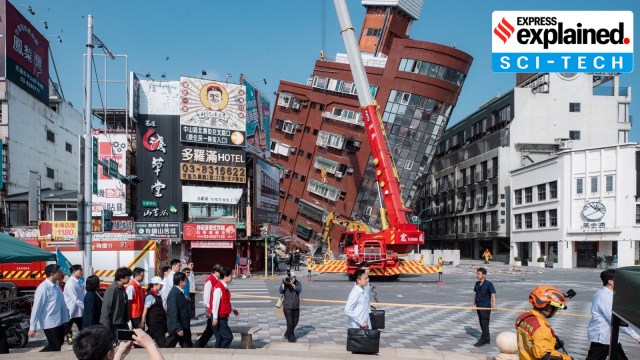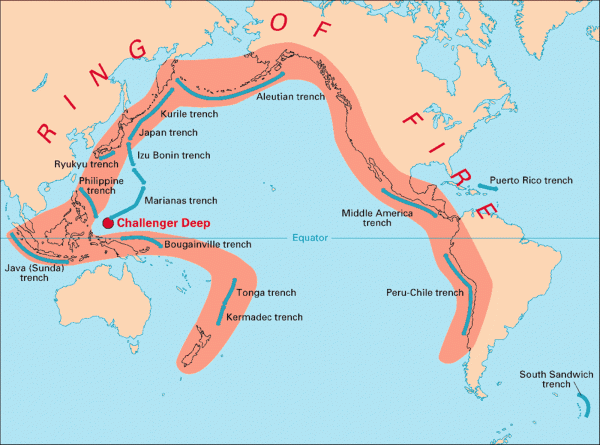- India
- International
Massive earthquake hits Taiwan: What is the Ring of Fire?
Taiwan is prone to earthquakes as it lies along the Pacific “Ring of Fire” — where 90% of the world’s earthquakes take place.
 Taiwan President-elect Lai Ching-te inspects the damage following the earthquake, in Hualien, Taiwan in this Taiwan Presidential Office handout image released April 3, 2024. (Photo: Reuters)
Taiwan President-elect Lai Ching-te inspects the damage following the earthquake, in Hualien, Taiwan in this Taiwan Presidential Office handout image released April 3, 2024. (Photo: Reuters) Nine people died and more than 1,000 were injured in Taiwan after the island was hit by its biggest earthquake in at least 25 years on Wednesday (April 4) morning. While Taiwan’s earthquake monitoring agency said the quake was 7.2 magnitude, the US Geological Survey (USGS) put it at 7.4.
The epicentre of the quake was located just 18 kilometres south-southwest of Hualien County, which is situated in eastern Taiwan. Multiple aftershocks were experienced, and one of them was 6.5 magnitude, according to USGS.
Notably, Taiwan is prone to earthquakes as it lies along the Pacific “Ring of Fire” — where 90% of the world’s earthquakes take place. The island and its surrounding waters have registered about 2,000 earthquakes with a magnitude of 4.0 or greater since 1980, and more than 100 earthquakes with a magnitude above 5.5, according to the USGS, a report by The Associated Press said.
Here is a look at the Ring of Fire and why so many earthquakes take place there.
What is the Ring of Fire?
The Ring of Fire is essentially a string of hundreds of volcanoes and earthquake-sites which runs along the Pacific Ocean. It is a semicircle or horse shoe in shape and stretches nearly 40,250 kilometres. The Ring of Fire traces the meeting points of numerous tectonic plates, including the Eurasian, North American, Juan de Fuca, Cocos, Caribbean, Nazca, Antarctic, Indian, Australian, Philippine, and other smaller plates, which all encircle the large Pacific Plate, according to a report by National Geographic.

It runs through 15 more countries including the USA, Indonesia, Mexico, Japan, Canada, Guatemala, Russia, Chile, Peru, and the Philippines.
 The map of the Pacific Ring of Fire. (Credit: USGS)
The map of the Pacific Ring of Fire. (Credit: USGS)
Why is the Ring of Fire vulnerable to earthquakes?
The Ring of Fire witnesses so many earthquakes due to constant sliding past, colliding into, or moving above or below each other of the tectonic plates. As the edges of these plates are quite rough, they get stuck with one another while the rest of the plate keeps moving. An earthquake occurs when the plate has moved far enough and the edges unstick on one of the faults.
Taiwan experiences earthquakes due to the interactions of two tectonic plates — the Philippine Sea Plate and the Eurasian Plate.
Why are there so many volcanoes in the Ring of Fire?
The existence of volcanoes in the Ring of Fire is also due to the movement of tectonic plates. Many of the volcanoes have been formed through a process known as subduction. It takes place when two plates collide with each other and the heavier plate is shoved under another, creating a deep trench.
“Basically, when a ‘downgoing’ oceanic plate [like the Pacific Plate] is shoved into a hotter mantle plate, it heats up, volatile elements mix, and this produces the magma. The magma then rises up through the overlying plate and spurts out at the surface,” which leads to the formation of volcanoes, according to a report by DW.
Most of the subduction zones on the planet are located in the Ring of Fire and that’s why it hosts a large number of volcanoes.
More Explained
EXPRESS OPINION
Apr 04: Latest News
- 01
- 02
- 03
- 04
- 05































